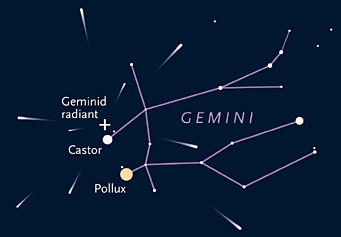Although an ancient Mayan calendar will reach its culmination on December 21st, you need not worry that the world will end. Instead, on that day Earth reaches a solstice point in its orbit at 6:12 a.m., Eastern Standard Time. This date marks the astronomical beginning of summer in the Southern Hemisphere and of winter up here in the north.
Soon after evening twilight you'll spot an incredibly bright “star” low in the east. That’s actually big, beautiful Jupiter. On December 2nd, the King of Planets reaches opposition, at a point in the sky opposite the Sun. This means it rises at sunset, looks highest around midnight, and sets at sunrise.

The radiant of the Geminid shower is near Castor, the fainter of the Twin Stars in Gemini.
S&T illustration
High in the north is Cassiopeia, surrounded by other constellations — Cepheus, Andromeda, and Perseus — that are all players in a grand mythic tale of danger and heroism.
The Geminid meteor shower peaks on the night of December 13th. From a clear, dark location, you might see one meteor per minute or more when it peaks The celestial display begins by 9 p.m and, with moonlight not a factor this year, it should be a great show.
For more tips to viewing this month's night sky by eye, download December's 6½-minute-long audio sky tour.
 0
0
Comments
You must be logged in to post a comment.